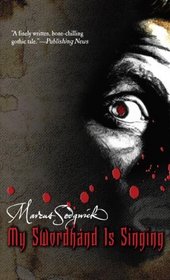Helpful Score: 1
Reviewed by Natalie Tsang for TeensReadToo.com
Marcus Sedgwick's MY SWORDHAND IS SINGING is a dark novel with a heavy emphasis on thick, snowy forests of Eastern Europe, gypsies, and superstitious town folk. It is the perfect setting for a scary story, but it is also much, much more.
Tomas and his teenage son, Peter, are a pair of traveling woodcutters with a mysterious past that settle down in the village of Chust one winter. Before long a string a deaths strike the village. Peter is perturbed by the villagers' strange reactions to the occurrences. When he asks Tomas about them, his father brushes away his questions as silly folk lore. However, Tomas is also doing his own share of strange things, like digging a trench around their home and filling it with moving water. When Agnes, a girl Peter likes, is symbolically married to a dead man and shut up in a remote hut, Peter tries to rescue her and runs into a monster.
Sedgwick takes pains to distance his tale from the gentleman bloodsucker that Anne Rice and authors like her have embedded into pop culture. The word "vampire" is never mentioned and the vampires, themselves, have varying appearances throughout the novel. He does a great job at weaving various and sometimes seemingly paradoxical pieces of folk lore. This gives the story a great sense of immediacy and realism. Sedgwick also shifts the focus from vampires to people who have to deal with terrifying occurrences at home. The buildup of the growing atmosphere of fear and denial will have readers biting their fingernails.
Marcus Sedgwick seems to take a lot of risks in writing this atypical, historically rich vampire novel. Central to the story line is not the relationship between a human and vampire or a girl and a boy (a la Buffy and Angel), but a wounded relationship between father and son. While this may seem terribly uncool, the realism of this relationship is what grounds the novel and makes the more fantastical elements more believable and scary.
Marcus Sedgwick's MY SWORDHAND IS SINGING is a dark novel with a heavy emphasis on thick, snowy forests of Eastern Europe, gypsies, and superstitious town folk. It is the perfect setting for a scary story, but it is also much, much more.
Tomas and his teenage son, Peter, are a pair of traveling woodcutters with a mysterious past that settle down in the village of Chust one winter. Before long a string a deaths strike the village. Peter is perturbed by the villagers' strange reactions to the occurrences. When he asks Tomas about them, his father brushes away his questions as silly folk lore. However, Tomas is also doing his own share of strange things, like digging a trench around their home and filling it with moving water. When Agnes, a girl Peter likes, is symbolically married to a dead man and shut up in a remote hut, Peter tries to rescue her and runs into a monster.
Sedgwick takes pains to distance his tale from the gentleman bloodsucker that Anne Rice and authors like her have embedded into pop culture. The word "vampire" is never mentioned and the vampires, themselves, have varying appearances throughout the novel. He does a great job at weaving various and sometimes seemingly paradoxical pieces of folk lore. This gives the story a great sense of immediacy and realism. Sedgwick also shifts the focus from vampires to people who have to deal with terrifying occurrences at home. The buildup of the growing atmosphere of fear and denial will have readers biting their fingernails.
Marcus Sedgwick seems to take a lot of risks in writing this atypical, historically rich vampire novel. Central to the story line is not the relationship between a human and vampire or a girl and a boy (a la Buffy and Angel), but a wounded relationship between father and son. While this may seem terribly uncool, the realism of this relationship is what grounds the novel and makes the more fantastical elements more believable and scary.




